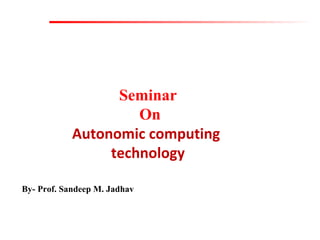
Autonomic Computing by- Sandeep Jadhav
- 1. Seminar On Autonomic computing technology By- Prof. Sandeep M. Jadhav
- 2. Introduction Autonomic computing is the technology that is building selfmanaging IT infrastructures—hardware and software that can configure, heal, optimize, and protect itself. By taking care of many of the increasingly complex management requirements of IT systems, autonomic computing allows human and physical resources to concentrate on actual business issues. The term autonomic computing derives from the body's autonomic nervous system, controlling functions like heart rate, breathing rate, and oxygen levels without a person's conscious awareness or involvement. The goal is to realize the promise of IT: increasing productivity while minimizing complexity for users. We are pursuing this goal on many technological fronts as we actively develop computing systems capable of running themselves with minimal human intervention.
- 3. Introduction
- 4. What is autonomic computing • • Autonomic computing is about freeing IT professionals to focus on high-value tasks by making technology work smarter. This means letting computing systems and infrastructure take care of managing themselves. Ultimately, it is writing business policies and goals and letting the infrastructure configure, heal and optimize itself according to those policies while protecting itself from malicious activities. Self managing computing systems have the ability to manage themselves and dynamically adapt to change in accordance with business policies and objectives. • In an autonomic environment the IT infrastructure and its
- 5. Self-management attributes of system components • In a self-managing autonomic environment, system components— from hardware (such as storage units, desktop computers and servers) to software (such as operating systems, middleware and business applications)—can include embedded control loop functionality. Although these control loops consist of the same fundamental parts, their functions can be divided into four broad embedded control loop categories. These categories are considered to be attributes of the system components and are defined as: • • Self-configuring • • Systems adapt automatically to dynamically changing environments. When hardware and software systems have the ability to define themselves "on-the fly," they are self-configuring. T
- 6. Eight key elements • Knows Itself • An autonomic computing system needs to "know itself - its components must also possess a system identity. Since a "system" can exist at many levels, an autonomic system will need detailed knowledge of its components, current status, ultimate capacity, and all connections to other systems to govern itself. It will need to know the extent of its "owned" resources, those it can borrow or lend, and those that can be shared or should be isolated. • • • Configure Itself An autonomic computing system must configure and reconfigure itself under varying (and in the future, even unpredictable) conditions. System configuration or "setup" must occur automatically, as well as dynamic adjustments to that configuration to best handle changing environments.
- 7. Autonomic manager internal structure • Monitor • The monitor function collects the details from the managed resources, via touchpoints, and correlates them into symptoms that can be analyzed. The details can include topology information, metrics, configuration property settings and so on. This data includes information about managed resource configuration, status, offered capacity and throughput. Some of the data is static or changes slowly, whereas other data is dynamic, changing continuously through time.
- 8. Benefits • • • • • • • Autonomic computing was conceived to lessen the spiraling demands for skilled IT resources, reduce complexity and to drive computing into a new era that may better exploit its potential to support higher order thinking and decision making. Immediate benefits will include reduced dependence on human intervention to maintain complex systems accompanied by a substantial decrease in costs. Long-term benefits will allow individuals, organizations and businesses to collaborate on complex problem solving. Short-term IT related benefits • Simplified user experience through a more responsive, real-time system. • Cost-savings - scale to use. • Scaled power, storage and costs that optimize usage across both hardware and software. • Full use of idle processing power, including home PC's, through networked system.
- 9. ChaIIenges • • • • • To create autonomic systems researchers must address key challenges with varying levels of complexity. They are • System identity: Before a system can transact with other systems it must know the extent of its own boundaries. How will we design our systems to define and redefine themselves in dynamic environments? • Interface design: With a multitude of platforms running, system administrators face a, How will we build consistent interfaces and points of control while allowing for a heterogeneous environment? • Translating business policy into I/T policy: The end result needs to be transparent to the user. How will we create human interfaces that remove complexity and allow users to interact naturally with I/T systems? • Systemic approach: Creating autonomic components is not enough. How can we unite a constellation of autonomic components into a federated system?
- 10. Conclusion • • • The autonomic concept has been adopted by today's leading vendors and incorporated into their products. Aware that success is tied to interoperability, many are participating in the standards development necessary to provide the foundation for self-managing technological ecosystems, and are integrating standards into their technology. IBM is making a substantial investment in the autonomic concept and has released its first wave of standards-based components, tools and knowledge capital. IBM offers a wide array of service offerings, backed by methodology and tools, which enable and support the adoption of Autonomic Computing. Autonomic capabilities are critical to businesses with large and complex IT environments, those using Web Services and/or Service Oriented Architecture (SOA) models, and those that leverage e-business or ecommerce. They are also key enablers for smaller businesses seeking to take advantage of current technologies, because they help mask complexity by simplifying infra-structure management.
